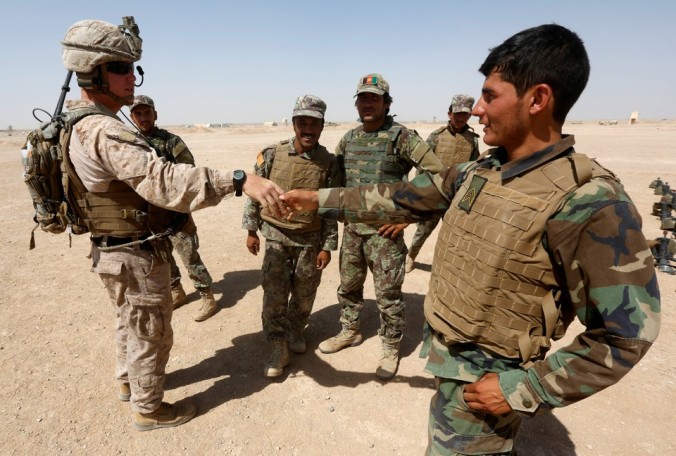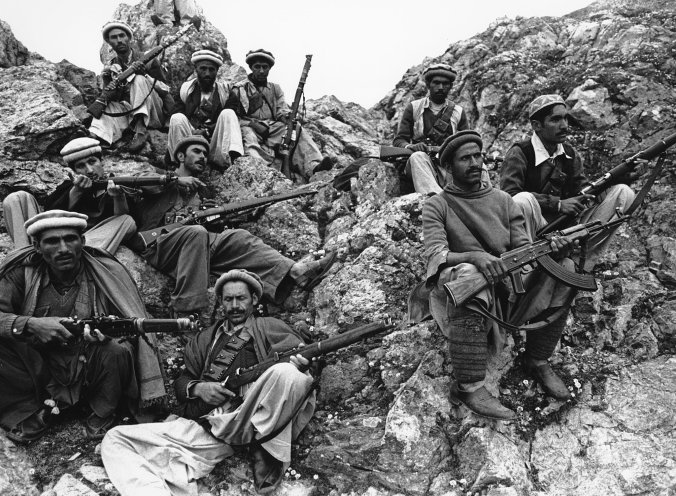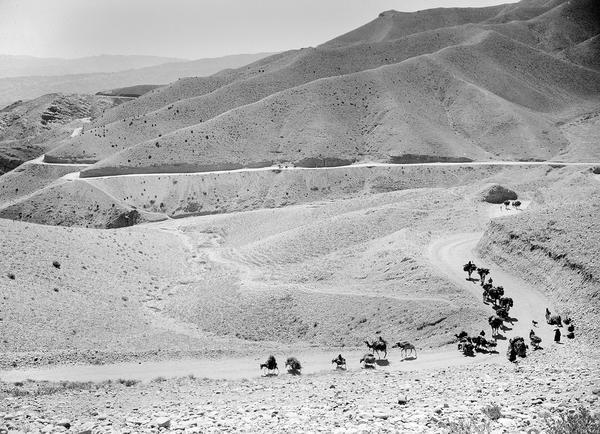 The president’s announcement of his own policy on Afghanistan essentially sounded like a rehash of the old but without a stated objective or strategy or timeline. In fact, he pretty much said he wasn’t going to divulge anything about strategy or troop strength, as that would be aiding and abetting the enemy. And long term goals are not in the CelebrityPresident’s wheelhouse; he’s strictly a president of now. And he loves the surprise ending. One thing we do know is that Trump’s America First is not in the business of nation building. Unfortunately, without that nation building piece, the United States will be stuck in Afghanistan for years and years, unless, of course, a nuclear holocaust has intervened or we give up the ghost and but out like in Vietnam.
The president’s announcement of his own policy on Afghanistan essentially sounded like a rehash of the old but without a stated objective or strategy or timeline. In fact, he pretty much said he wasn’t going to divulge anything about strategy or troop strength, as that would be aiding and abetting the enemy. And long term goals are not in the CelebrityPresident’s wheelhouse; he’s strictly a president of now. And he loves the surprise ending. One thing we do know is that Trump’s America First is not in the business of nation building. Unfortunately, without that nation building piece, the United States will be stuck in Afghanistan for years and years, unless, of course, a nuclear holocaust has intervened or we give up the ghost and but out like in Vietnam.
Congress holds the purse strings for conducting war and Trump told them that he will not disclose the strategy, or objectives, limiting their role in or ability to appropriately fund the war. General Matiss will go to Congress to persuade them but they won’t be too receptive. They’ve ceded a lot of war powers already, with McCain leading the charge to take it back. Apparently, the generals’ request for a mere 4000 additional troops played a large part in convincing 45 to stray from America First non-interventionism. That and the slam dunk “eliminating terrorism rally cry”, at least the Islamic kind, from the face of the planet. He can’t be known as the president losing the war on terrorism because the CelebrityPresident is always winning.
Like the bull in the china shop that he is, the BullyPresident knocked over a tea stand when he poked Pakistan about increasing their anti-terrorist efforts by promoting India, their nuclear armed arch enemy in the region. Pakistan has responded by visiting allies in China and in India to argue their case that they are actively rooting out terrorists, at least far more actively than they have in the past. Any new sanctions against Pakistan are likely to be as ineffective in changing that country’s chosen course as those that were levied to stop the Pakistan nuclear weapons program. China as a powerful ally can easily counterbalance any sanctions. They’re all convinced that the US will pull out, just as the British and the Russians did before them and they’re betting more on the short term rather than the long. The implications of a Taliban controlled Afghanistan destabilizing the region is the primary concern for these neighbors, so some are hedging their bets now.
A brief review of the history of Afghanistan may help in understanding the territory now. Afghanistan, made up of 34 provinces, is bordered by India, Pakistan, Uzbekistan, Turkmenistan, Iran and China. Historically, the country has stood at the peripheral interface of imperial wars. In the 19th century, it was the boundary of the standoff between the British and Russian Empires. In the mid 20th century, it was the Cold War, when the Soviet Union faced off in a guerilla war against the US ensconced in a global anti-communist campaign to save democracies, and some would say create faux-democracies around the world. In the 21st century it has been the war on militant Islamic terrorism. Afghanistan with its vast mountainous terrain and narrow passes bedeviled them all, with ill equipped tribesman bringing well-equipped armies to their knees.
 Beginning in 1839, the British Empire fought three wars in the country for over 80 years, finally withdrawing in 1919 by granting Afghanistan independence at the close of WWI. The Soviet Union invaded Afghanistan in 1979 to support the government in a developing civil war during an era where they were extending a policy of stabilizing the neighboring Asian republics of now Kazakhstan, Uzbekistan, Turkmenistan and Tajikistan. Unlike those other countries, the Afghans proved difficult to manage assisted by the United States, Pakistan and Saudi Arabia. The Soviets like the British before them found themselves isolated in the Afghan capital of Kabul and other well fortified positions scattered in a vast sea of hostile countryside, controlled by rebellious warlords. When the Soviet army limped out of the country in 1989, they left the country with more landmines than anywhere else on the planet and a puppet regime that disintegrated into years of civil wars. Those wars set the stage for the rise of the Taliban.
Beginning in 1839, the British Empire fought three wars in the country for over 80 years, finally withdrawing in 1919 by granting Afghanistan independence at the close of WWI. The Soviet Union invaded Afghanistan in 1979 to support the government in a developing civil war during an era where they were extending a policy of stabilizing the neighboring Asian republics of now Kazakhstan, Uzbekistan, Turkmenistan and Tajikistan. Unlike those other countries, the Afghans proved difficult to manage assisted by the United States, Pakistan and Saudi Arabia. The Soviets like the British before them found themselves isolated in the Afghan capital of Kabul and other well fortified positions scattered in a vast sea of hostile countryside, controlled by rebellious warlords. When the Soviet army limped out of the country in 1989, they left the country with more landmines than anywhere else on the planet and a puppet regime that disintegrated into years of civil wars. Those wars set the stage for the rise of the Taliban.
 The United States began a new war soon after 9/11. In the interim, more than one million American soldiers have served in the country, over 2400 have lost their lives and Afghan civilians are still dying at a rate of over 3000 annually. Now 16 years in, so far this year, there have been 11 American casualties. After a peak military presence of 100,000 soldiers, a force of about 12,000 American “military advisors and trainers” support about 300,000 Afghan security forces, stationed in isolated bases, much like the British and Soviets had been. Many suspect that the number of Afghan troops is overestimated by as much as 40%, similar to the “ghost soldier” in Iraq, a name on the military rolls unassociated with a body that is drawing a salary.
The United States began a new war soon after 9/11. In the interim, more than one million American soldiers have served in the country, over 2400 have lost their lives and Afghan civilians are still dying at a rate of over 3000 annually. Now 16 years in, so far this year, there have been 11 American casualties. After a peak military presence of 100,000 soldiers, a force of about 12,000 American “military advisors and trainers” support about 300,000 Afghan security forces, stationed in isolated bases, much like the British and Soviets had been. Many suspect that the number of Afghan troops is overestimated by as much as 40%, similar to the “ghost soldier” in Iraq, a name on the military rolls unassociated with a body that is drawing a salary.
The military position of the Taliban changes from week to week. Some authorities contend that the organization has growing momentum. Despite heavy casualties, estimated to be 20,000 in 2012 and over 10,000 annually they appear to have no trouble recruiting. When the Khamab district was overrun by the Taliban during the week of Trump’s Afghanistan announcement, it was the sixth government held territory to fall. They have seized several provincial capitals, but have not held them successfully. Still they control and dominate the surrounding countryside, as much as 48% of 400 administrative districts, from which they disrupt supply lines and commerce as well as kill Afghan forces and civilians. They also control Helmand province where 80% of opium is produced, a hugely lucrative source of financial support.
Meanwhile, the Afghan government of Hamid Karzai is facing street protests over lack of security and political unrest. The Taliban influence in Kabul, once considered a relatively safe place, is growing, evident in stepped up terrorist attacks in the capital, despite the intense and concentrated security. The government is also beset with internecine conflict between pro-government warlords.
The Taliban has proven more tenacious than back in 2008, killing more Afghan government soldiers, police and the elite special forces. The strength of the Taliban lies in its administration of rural and urban governments. They deliver government services, like utilities and schools, that the Karzai government is not. Trump has characterized the struggle for Afghanistan as a war to drive out the radical Islamists in order that the people determine their own future. But wiping out those characterized as terrorists may be killing normal Afghani who have chosen lives with the public services that the Taliban have provided as preferable to some undefined concept of democratic government which in their country has meant only some form of oppression and corruption. The average illiterate Afghan has no idea what democracy means.
But the Taliban we thought we knew has evolved as newly radicalized groups have come onto the scene. It appears that the Haqqani Network, once a marginal faction known for running a suicide bomber training camp in Pakistan, has now assumed leadership of the organization. The Haqqani Network was deemed responsible for the most deadly attacks in Kabul. At this point. no one currently in Taliban leadership is interested in peace talks. General Matiss has said that American policy is now aimed at enhancing the territorial position of Afghan governmental forces to coerce the Taliban to peace talks, conceding a stalemate.
There are still other players in the Afghanistan shell game. Iran is supporting the government while it has intermittent relations with the Taliban. And then there is the incursion of ISIS forces, associated with the Islamic State in Iraq and Syria, which has gained power in Khorasan. There are an estimated 50,000 jihadists and 4000 extremist groups fighting each other in Afghanistan. The UN estimates that ISIS has a presence in 25 of the country”s provinces. The Taliban sees ISIS as a potential rival, forcing them to become more radical and more violent. Altogether, some experts estimate that insurgents hold up to 60% of the countryside. The government contests or controls 35%, which is actually a quantum leap over the last year.
Vladimir Putin hasn’t overlooked the ISIS presence in the region. Russia believes that there more than 3000 fighters have come from the Northern Caucasus. It fears that the jihadists may spark militancy in Central Asia and southern Russia, making the situation in Putin’s mind, “close to critical”. Putin is not one to demur when territorial loss or pushback against his authoritarian regime in question. Russian assessment of the current situation has led them to take their own action. Moscow is currently negotiating with Kabul to provide combat helicopters and heavy weapons, assault rifles and tons of ammunition. It has also been training Afghan troops, slated to be expanded as NATO involvement in the conflict diminishes. To complement its efforts with the government, they are also negotiating with the Taliban, as part of its effort to combat the rise of ISIS.
Much to the surprise of the anti-jihadists forces, the Taliban seized the city of Kunduz in northern Afghanistan near the border with Tajikistan. The Taliban has also popped up in Badakhshan, another province of the Tajikistan border. These are new areas of incursion, ethnically more akin to the recruiting base of the former Northern Alliance, a Taliban enemy. It now appears that the support for this group is coming from Tajikistan, suggesting some involvement from the Kremlin. For its part, the Taliban has shown no propensity to challenge Russian influence in Central Asia or at home. Moscow seems content to use the Taliban as a temporary buffer to shield Tajikistan from the war against other radical Muslim groups.
The Russians view Islamist ideology as a variant of Afghan tribalism and nationalism rather than a global conspiracy. Their primary objective is to keep it within Afghanistan’s borders. Moscow’s fear is that well-trained ISIS-like groups flush with cash will bribe Taliban leaders and splinter the group from within. To that end, they want to strengthen the Taliban against its rival groups through supporting its leadership and its preparedness. Moscow, not wanting to repeat the US blunder of arming the mujahideen, is being careful to limit its support to a range of more unsophisticated weapons.
At the same time, the Kremlin is hedging its bets by building up its military presence in Tajikistan. It has been continuously reinforcing a Russian division in that country with both soldiers and attack helicopters.
Perhaps 45 has an insider link to Moscow’s maneuvering and is factoring those unknown bits into his Afghanistan scheme, letting the Russians do more of the heavy lifting there just as he’s done in Syria. Surely US Intelligence knows this stuff and they’ve passed it on the generals; they’re just not cluing the public in. The Trumpophants don’t care and that’s all that concerns the CelebrityPresident. Still Afghanistan is far more complicated than most of the public realizes. The situation, fluid and dynamic as it is, has multiple fingers dipping in the mix and that suggests a chaotic future for years to come.